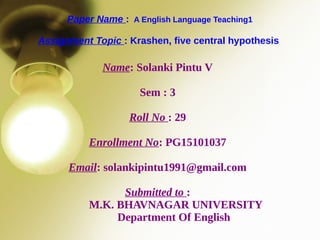
Krashen, five central hypothesis
- 1. Paper Name : A English Language Teaching1 Assignment Topic : Krashen, five central hypothesis Name: Solanki Pintu V Sem : 3 Roll No : 29 Enrollment No: PG15101037 Email: solankipintu1991@gmail.com Submitted to : M.K. BHAVNAGAR UNIVERSITY Department Of English
- 2. Stephen Krashen About 25 years ago, a psychologist named Stephen Krashen transformed language teaching. He had been developing his ideas over a number of years, but several books he published in the 1980s received widespread acceptance.
- 3. ➔ According to Krashen’s acquisition-learning hypothesis, there are two independent ways to develop our linguistic skills: acquisition and learning. ➔ This theory is at the core of modern language acquisition theory, and is perhaps the most fundamental of Krashen's theories on second acquisition.
- 4. Krashen, five central hypothesis 1.The Acquisition-Learning Hypothesis 2.The Monitor Hypothesis 3.The Natural Order Hypothesis 4.The Input Hypothesis 5.The Affective Filter Hypothesis
- 5. The Acquisition-Learning Hypothesis ● Learning- conscious, Acquisition-unconscious ● “Learning” does not turn into “acquisition”, says Krashen
- 6. Claims ● Sometimes there is Acquisition without Learning- people can speak without knowing rules consciously ● Sometimes learning never becomes acquisition- knows the rule but always breaks it ● No-one knows anywhere near all the rules
- 7. The Monitor Hypothesis ➔ Learning has only one function, that is as a Monitor or editor ➔ Acquisition initiates the speaker’s utterances and is responsible for Fluency
- 8. 3 conditions for Monitor use Time Focus on form/ correctness Know the rule All these are problematic, difficult to demonstrate
- 9. Krashen explained the individual differences on the Monitor concept 1)Monitor over-users 2)Monitor under-users 3)Optimal monitor users
- 10. Adults vs. Children ✔ Children are better learners because they do not use the Monitor
- 11. Problems Acquisition-learning distinction not clearly defined The theory that learning will not become acquisition can’t be tested empirically It is only in the phonological development that children do better! We simply cannot unequivocally identify the source of any utterance!
- 12. The Natural Order Hypothesis We acquire rules in a predictable order, some rules tending to come early and others late. The order of rules is not determined by its simplicity and is independent of the order in which rules are taught
- 13. The acquisition of grammatical structures follows a “natural order” which is predictable. English is perhaps the most studied language as far as natural order hypothesis is concerned, and of all structures of English, morphology is the most studied.
- 14. Krashen believes that the implication of the natural order hypothesis is not that our syllabi should be based on the order found in the studies. The only instance in which the teaching of grammar can result in language acquisition is when the students are interested in the subject and the target language is used as a medium of instruction.
- 15. The Input Hypothesis We acquire language only when we understand language that contains structure that is “a little beyond” where we are now. This is possible because we use more than our linguistic competence to help us understand.
- 16. The input hypothesis says that we acquire by “going for meaning” first, and as a result, we acquire structure. It also states that speaking fluency cannot be taught directly. It emerges over time, on its own.
- 17. The Input Hypothesis doesn’t explain ➔ How learners progress form understanding to acquisition ➔ What is “comprehensible input”, not clear ➔ …just beyond the syntactic complexity of what he knows at present… - impossible to define clearly
- 18. The Affective Filter Hypothesis The Affective Filter hypothesis, embodies Krashen's view that a number of 'affective variables' play a facilitative, but non-causal, role in second language acquisition. These variables include: motivation, self- confidence and anxiety.
- 19. Low motivation, low self-esteem, and debilitating anxiety can combine to 'raise' the affective filter and form a 'mental block' that prevents comprehensible input from being used for acquisition. In other words, when the filter is 'up' it impedes language acquisition.
- 20. Krashen claims that learners with high motivation, self-confidence, a good self-image, and a low level of anxiety are better equipped for success in second language acquisition.
- 21. Conclusion The acquisition-learning hypothesis is at the core of modern language acquisition theory, and is perhaps the most fundamental of Krashen's theories on second acquisition.